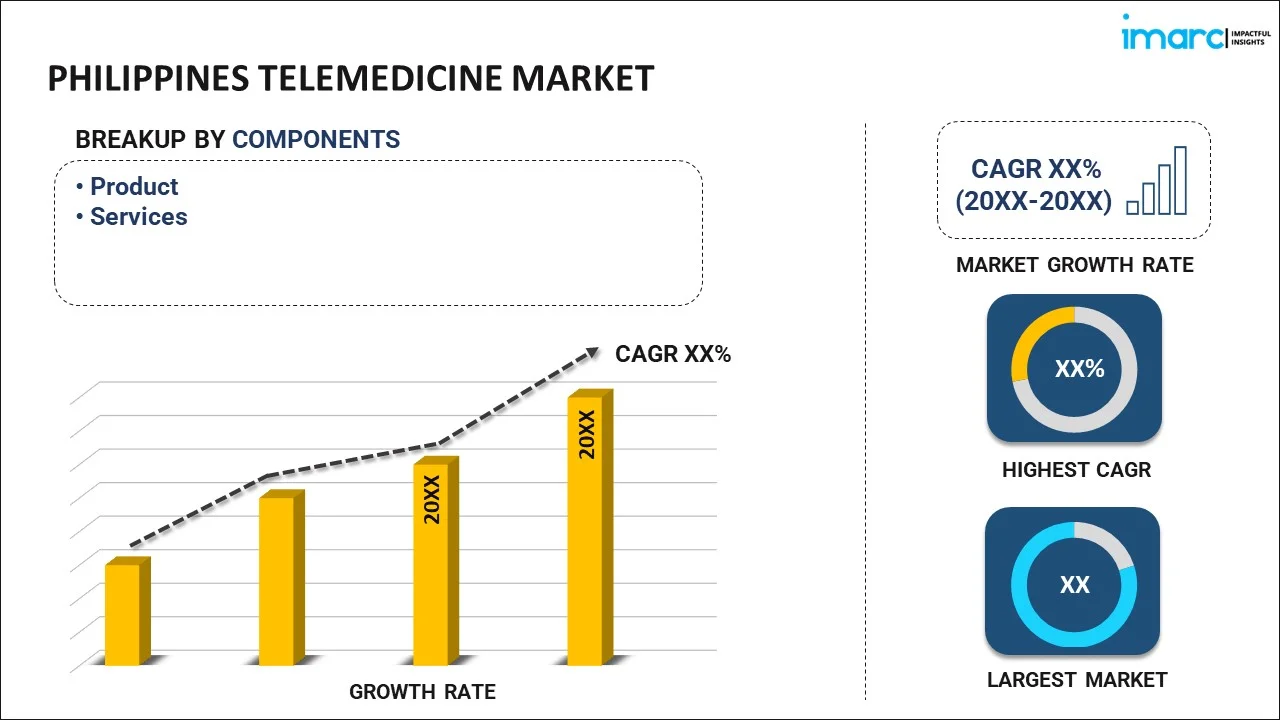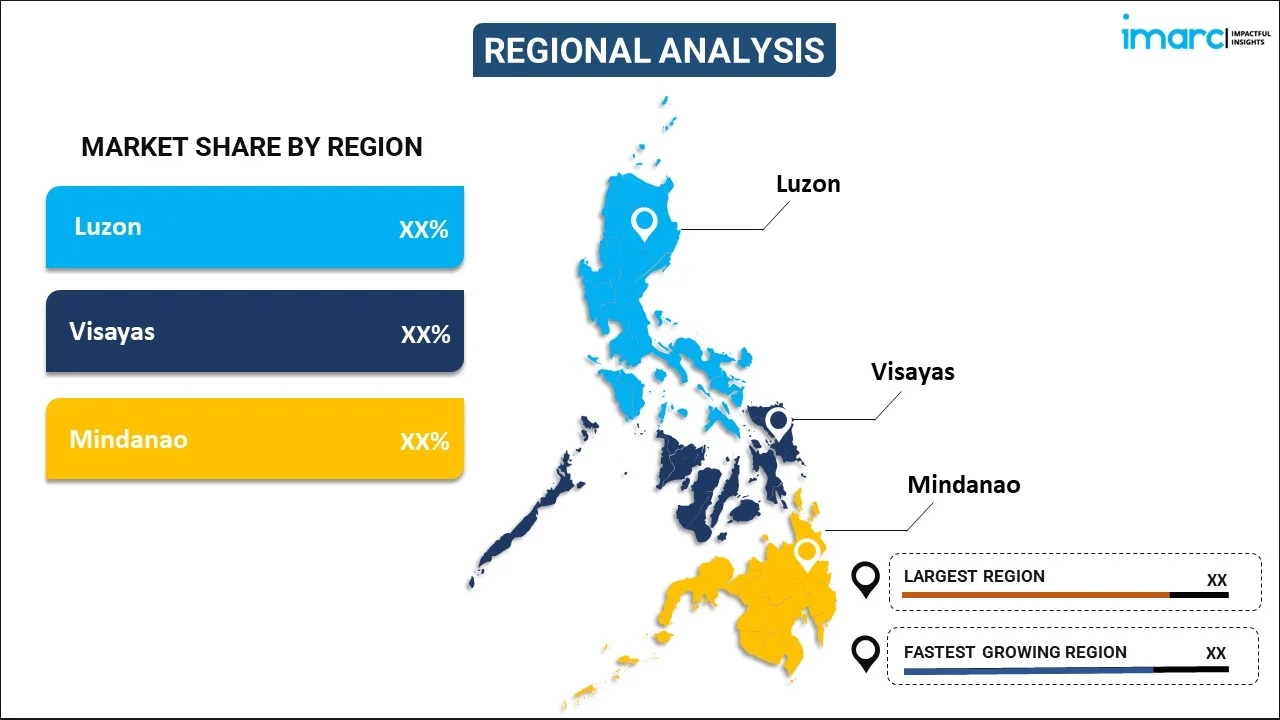
Philippines Telemedicine Market Report by Component (Product, Services), Modality (Real-Time, Store and Forward, and Others), Delivery Mode (Web/Mobile, Call Centers), Facility (Tele-hospital, Tele-home), Application (Teledermatology, Teleradiology, Telepsychiatry, Telepathology, Telecardiology, and Others), End User (Providers, Payers, Patients, and Others), and Region 2025-2033
Philippines Telemedicine Market Overview:
The Philippines telemedicine market size is projected to exhibit a growth rate (CAGR) of 17% during 2025-2033. The increased healthcare demand, advancements in technology, improved internet access, favorable and supportive government policies, the sudden outbreak of COVID-19 pandemic and the consequently rising health awareness and a need for convenient, remote healthcare solutions are some of the key factors propelling the growth of the market.
|
Report Attribute
|
Key Statistics
|
|---|---|
|
Base Year
|
2024 |
|
Forecast Years
|
2025-2033
|
|
Historical Years
|
2019-2024
|
| Market Growth Rate (2025-2033) | 17% |
Philippines Telemedicine Market Trends:
Increased Healthcare Demand
The growing population and rising prevalence of chronic diseases drive the demand for accessible healthcare services, which telemedicine can provide efficiently. According to data from the World Health Organization (WHO), a staggering 511,748 Filipinos lost their lives to NCDs in 2019 alone. This statistic is particularly alarming when considering that 72% of these deaths occurred among women, and 68% among men, underscoring the pervasive impact of NCDs across gender lines. According to a report by the WHO and the United Nations Development Programme (UNDP), the economic cost of NCDs in the Philippines amounted to PHP 756.5 billion, highlighting the need for targeted investments in prevention, early detection, and management initiatives. The Centers for Disease Control and Prevention (CDC) established an office in the Philippines in 2022 to partner with the Philippines Department of Health. Through initiatives such as the President's Emergency Plan for AIDS Relief (PEPFAR), CDC focuses on closing gaps in HIV prevention and treatment in the Philippines.
Significant Technological Advancements
Innovations in medical technology, telecommunication, and digital health platforms enhance the feasibility and effectiveness of telemedicine services. For instance, CareGo EMR is an early-stage startup that is focused on co-developing healthcare innovation with rural communities in the Philippines. The team’s combined work experience in public healthcare, academia, and information technology aims to deliver human-centered solutions to achieve the company’s long-term vision of more equitable healthcare in the Philippines. For instance, in March 2024, the Medical City (TMC) continues solidifying its legacy as the Philippines' leader in healthcare innovation, marking a year of significant achievement and growth. In the past year, TMC embraced artificial intelligence (AI) and has integrated it into its imaging services for chest X-rays. This has significantly enhanced the hospital's diagnostic capabilities, elevating the compliance rate for finalizing chest X-ray results from 98% to an impressive 99.88%. Similarly, in April 2024, Unilab Foundation (ULF) launched the Unilab Center for Health Policy (UCHP), a venue for stakeholders to examine health policy issues. UCHP is intended to provide a platform for policy makers, the private sector, implementors, and other concerned stakeholders at the national and local levels—to discuss, distill, and dissect health policy issues.
Philippines Telemedicine Market News:
In March 2024, Novartis Healthcare Philippines and AC Health launched an Integrated Cardiovascular and Cancer Care partnership that aims to broaden access to innovative medicines for breast cancer, heart failure, and high cholesterol, as well as to empower the patient community.
In June 2024, FUJIFILM Philippines, a leading provider of innovative imaging and healthcare solutions, partnered with the City Government of Makati to provide free, high-quality diagnostic services to residents through its weekly caravan in various barangays.
Philippines Telemedicine Market Segmentation:
IMARC Group provides an analysis of the key trends in each segment of the market, along with forecasts at the country level for 2025-2033. Our report has categorized the market based on component, modality, delivery mode, facility, application, and end user.
Component Insights:

- Product
- Hardware
- Software
- Others
- Services
- Tele-consulting
- Tele-monitoring
- Tele-education
The report has provided a detailed breakup and analysis of the market based on the component. This includes product (hardware, software, and others) and services (tele-consulting, tele-monitoring, and tele-education).
Modality Insights:
- Real-time
- Store and Forward
- Others
A detailed breakup and analysis of the market based on the modality have also been provided in the report. This includes real-time, store and forward, and others.
Delivery Mode Insights:
- Web/Mobile
- Audio/Text-based
- Visualized
- Call Centers
The report has provided a detailed breakup and analysis of the market based on the delivery mode. This includes web/mobile (audio/text-based and visualized) and call centers.
Facility Insights:
- Tele-hospital
- Tele-home
A detailed breakup and analysis of the market based on the facility have also been provided in the report. This includes tele-hospital and tele-home.
Application Insights:
- Teledermatology
- Teleradiology
- Telepsychiatry
- Telepathology
- Telecardiology
- Others
The report has provided a detailed breakup and analysis of the market based on the application. This includes teledermatology, teleradiology, telepsychiatry, telepathology, telecardiology, and others.
End User Insights:
- Providers
- Payers
- Patients
- Others
A detailed breakup and analysis of the market based on the end user have also been provided in the report. This includes providers, payers, patients, and others.
Regional Insights:

- Luzon
- Visayas
- Mindanao
The report has also provided a comprehensive analysis of all the major regional markets, which include Luzon, Visayas, and Mindanao.
Competitive Landscape:
The market research report has also provided a comprehensive analysis of the competitive landscape. Competitive analysis such as market structure, key player positioning, top winning strategies, competitive dashboard, and company evaluation quadrant has been covered in the report. Also, detailed profiles of all major companies have been provided.
Philippines Telemedicine Market Report Coverage:
| Report Features | Details |
|---|---|
| Base Year of the Analysis | 2024 |
| Historical Period | 2019-2024 |
| Forecast Period | 2025-2033 |
| Units | Million USD |
| Scope of the Report | Exploration of Historical and Forecast Trends, Industry Catalysts and Challenges, Segment-Wise Historical and Predictive Market Assessment:
|
| Components Covered |
|
| Mobilities Covered | Real-Time, Store and Forward, Others |
| Delivery Modes Covered |
|
| Facilities Covered | Tele-hospital, Tele-home |
| Applications Covered | Teledermatology, Teleradiology, Telepsychiatry, Telepathology, Telecardiology, Others |
| End Users Covered | Providers, Payers, Patients, Others |
| Regions Covered | Luzon, Visayas, Mindanao |
| Customization Scope | 10% Free Customization |
| Post-Sale Analyst Support | 10-12 Weeks |
| Delivery Format | PDF and Excel through Email (We can also provide the editable version of the report in PPT/Word format on special request) |
Key Questions Answered in This Report:
- How has the Philippines telemedicine market performed so far and how will it perform in the coming years?
- What has been the impact of COVID-19 on the Philippines telemedicine market?
- What is the breakup of the Philippines telemedicine market on the basis of component?
- What is the breakup of the Philippines telemedicine market on the basis of modality?
- What is the breakup of the Philippines telemedicine market on the basis of delivery mode?
- What is the breakup of the Philippines telemedicine market on the basis of facility?
- What is the breakup of the Philippines telemedicine market on the basis of application?
- What is the breakup of the Philippines telemedicine market on the basis of end user?
- What are the various stages in the value chain of the Philippines telemedicine market?
- What are the key driving factors and challenges in the Philippines telemedicine?
- What is the structure of the Philippines telemedicine market and who are the key players?
- What is the degree of competition in the Philippines telemedicine market?
Key Benefits for Stakeholders:
- IMARC’s industry report offers a comprehensive quantitative analysis of various market segments, historical and current market trends, market forecasts, and dynamics of the Philippines telemedicine market from 2019-2033.
- The research report provides the latest information on the market drivers, challenges, and opportunities in the Philippines telemedicine market.
- Porter's five forces analysis assist stakeholders in assessing the impact of new entrants, competitive rivalry, supplier power, buyer power, and the threat of substitution. It helps stakeholders to analyze the level of competition within the Philippines telemedicine industry and its attractiveness.
- Competitive landscape allows stakeholders to understand their competitive environment and provides an insight into the current positions of key players in the market.
Need more help?
- Speak to our experienced analysts for insights on the current market scenarios.
- Include additional segments and countries to customize the report as per your requirement.
- Gain an unparalleled competitive advantage in your domain by understanding how to utilize the report and positively impacting your operations and revenue.
- For further assistance, please connect with our analysts.
 Inquire Before Buying
Inquire Before Buying
 Speak to an Analyst
Speak to an Analyst
 Request Brochure
Request Brochure
 Request Customization
Request Customization




.webp)




.webp)












